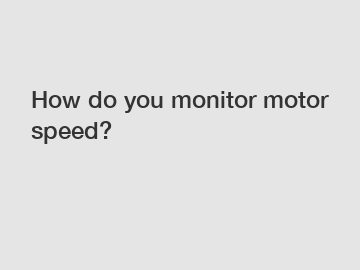How do you monitor motor speed?
Mar. 27, 2024
Monitoring motor speed is a crucial part of many industrial processes and applications. Whether you are operating a conveyor belt, a robotic arm, or a manufacturing machine, keeping track of the speed of your motors is essential for maintaining efficiency, safety, and productivity. In this blog post, we will explore the various methods and techniques used to monitor motor speed and discuss their advantages and limitations.
One of the most common and straightforward methods of monitoring motor speed is by using an encoder. An encoder is a device that converts the rotational motion of a motor shaft into electrical signals that can be used to determine the speed and position of the motor. There are two main types of encoders: absolute encoders and incremental encoders. Absolute encoders provide a precise and unambiguous measurement of the motor's position, while incremental encoders produce a series of pulses that can be counted to calculate speed and distance.
Encoders are highly accurate and reliable, making them a popular choice for monitoring motor speed in industrial applications. They are also easy to install and require minimal maintenance. However, encoders can be relatively expensive and may not be suitable for all types of motors or operating environments.

Another common method of monitoring motor speed is through the use of tachometers. A tachometer is a device that measures the rotational speed of a motor shaft by detecting changes in voltage or frequency. Tachometers are simple to install and cost-effective, making them a popular choice for monitoring motor speed in a wide range of applications. However, tachometers are less accurate than encoders and may not provide real-time data on motor speed.
In addition to encoders and tachometers, there are also more advanced methods of monitoring motor speed, such as using frequency counters, Hall effect sensors, and motor controllers. Frequency counters measure the frequency of the electrical signals produced by the motor and can be used to calculate motor speed. Hall effect sensors detect changes in magnetic field strength and can be used to monitor the position and speed of the motor shaft. Motor controllers can regulate the speed of a motor and provide feedback on its performance.
Monitoring motor speed is essential for maintaining the efficiency and safety of industrial processes. By monitoring motor speed, operators can detect and address issues such as overheating, overloading, and wear and tear on the motor. Monitoring motor speed can also help optimize energy consumption and reduce maintenance costs.
In conclusion, there are various methods and techniques available for monitoring motor speed, each with its advantages and limitations. Encoders are highly accurate and reliable but can be expensive. Tachometers are simple and cost-effective but less accurate. Advanced methods such as frequency counters, Hall effect sensors, and motor controllers offer additional functionalities but may require more expertise to implement.
Regardless of the method chosen, monitoring motor speed is a critical aspect of industrial operations that can help improve efficiency, safety, and productivity. By investing in the right monitoring equipment and techniques, operators can ensure that their motors are running smoothly and effectively, leading to better performance and reduced downtime.
Want more information on how much weight drone can carry, coaxial propeller efficiency, drone torque? Feel free to contact us.
27
0
0
None
None

Comments
All Comments (0)